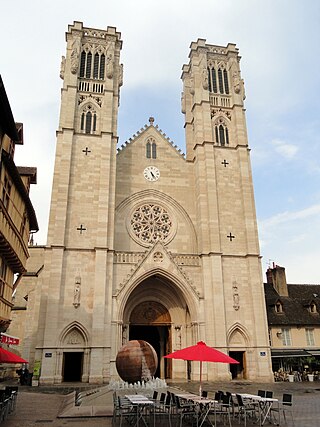
Chlothar II, sometimes called "the Young", was king of the Franks, ruling Neustria (584–629), Burgundy (613–629) and Austrasia (613–623).

Chlothar I, sometime called "the Old", also anglicised as Clotaire, was a king of the Franks of the Merovingian dynasty and one of the four sons of Clovis I.

Regino of Prüm or of Prum was a Benedictine monk, who served as abbot of Prüm (892–99) and later of Saint Martin's at Trier, and chronicler, whose Chronicon is an important source for late Carolingian history.
Fredegund or Fredegunda was the queen consort of Chilperic I, the Merovingian Frankish king of Soissons. Fredegund served as regent during the minority of her son Chlothar II from 584 until 597.

Charibert I was the Merovingian King of Paris, the second-eldest son of Chlothar I and his first wife Ingund. His elder brother Gunthar died sometime before their father's death. He shared in the partition of the Frankish kingdom that followed his father's death in 561, receiving the old kingdom of Childebert I, with its capital at Paris.
In the medieval Roman Catholic church there were several Councils of Tours, that city being an old seat of Christianity, and considered fairly centrally located in France.
The Council of Epaone or Synod of Epaone was held in September 517 at Epaone in the Burgundian Kingdom.
The Council of Agde was a regional synod held in September 506 at Agatha or Agde, on the Mediterranean coast east of Narbonne, in the Septimania region of the Visigothic Kingdom, with the permission of the Visigothic King Alaric II.
The First Council of Orléans was convoked by Clovis I, King of the Franks, in 511. Clovis called for this synod four years after his victory over the Visigoths under Alaric II at the Battle of Vouillé in 507. The council was attended by thirty-two bishops, including four metropolitans, from across Gaul, and together they passed thirty-one decrees. The bishops met at Orléans to reform the church and construct a strong relationship between the crown and the Catholic episcopate, the majority of the canons reflecting compromise between these two institutions.

The Edict of Paris was promulgated 18 October 614 in Paris by Chlothar II, the Merovingian king of the Franks. It is a body of legislation focused on administering justice and ensuring the rights of the church, aristocracy, and people of Francia. The 24-article Edict was issued directly after the Council of Paris; many of its clauses were based on the canons of the church council. It is the last of the Merovingian capitularia, a series of legal ordinances governing church and realm.
Collections of ancient canons contain collected bodies of canon law that originated in various documents, such as papal and synodal decisions, and that can be designated by the generic term of canons.
Eufronius or Euphronius was the eighth Bishop of Tours; he served from 555 to 573, and was a near relative of Gregory of Tours.

The former French Catholic diocese of Chalon-sur-Saône existed until the French Revolution. After the Concordat of 1801, it was suppressed, and its territory went to the diocese of Autun. Its see was Chalon Cathedral.
Reims, located in the north-east of modern France, hosted several councils or synods in the Roman Catholic Church. These councils did not universally represent the church and are not counted among the official ecumenical councils.
In the Roman Catholic Church, a plenary council is any of various kinds of ecclesiastical synods, used when those summoned represent the whole number of bishops of some given territory. The word itself, derived from the Latin plenarium, hence concilium plenarium, also concilium plenum. Plenary councils have a legislative function that does not apply to other national synods.
The Council of Toul was a Frankish synod convoked by Theudebald, King of Austrasia, that convened in Toul on 1 June 550. It is not known how many bishops attended. It extended to the ecclesiastical provinces of Reims and Trier and perhaps beyond. The diocese of Toul was a suffragan of Trier. The metropolitan bishop, Nicetius of Trier, was certainly in attendance.
The Synod of Worms of May 868 was a council of the church in East Francia, convoked by King Louis the German at the request of Pope Nicholas I. It condemned the Synod of Constantinople of 867 as heretical and condemned Great Moravia for rebelling against Louis.
Saint Agilus was a Frankish nobleman who became a Christian missionary in Bavaria and later was abbot of Rebais monastery near Paris, France. He was considered a saint, and his feast day is 30 August.

Theodore was the bishop of Marseille from at least 566 until 591/594. In the 580s, Theodore was at the centre of a dispute over the city of Marseille between King Guntram and his nephew, King Childebert II. He was arrested several times. His troubles are recorded by the contemporary historian Gregory of Tours, who depicts him as a saintly albeit powerless figure who was supported by the laity, but opposed by his own clergy.